#california carnivores
Text
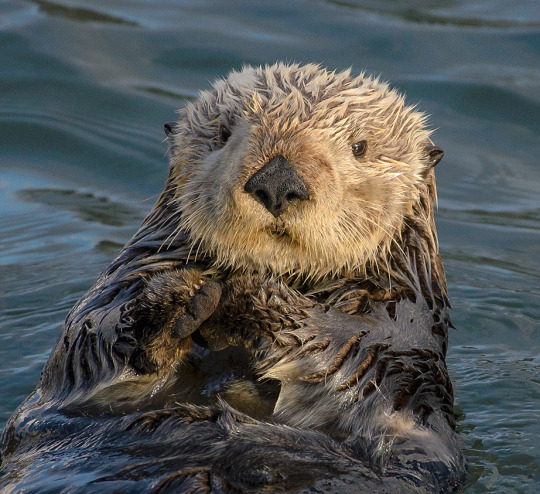
Sea otter
“A close-up of a sea otter, taken in Morro Bay, California in 2016.” - via Wikimedia Commons
#sea otter#enhydra kurtis#wikipedia#wikipedia pictures#wikimedia commons#nature#animals#marine animals#marine mammals#weasel family#carnivora#carnivores#mustelidae#mustelid#lutrinae#enhydra#otters#ocean animals#sea animals#marine life#marine biology#marine biodiversity#oceancore#morro bay#california#california coast#united states#north america
48 notes
·
View notes
Text
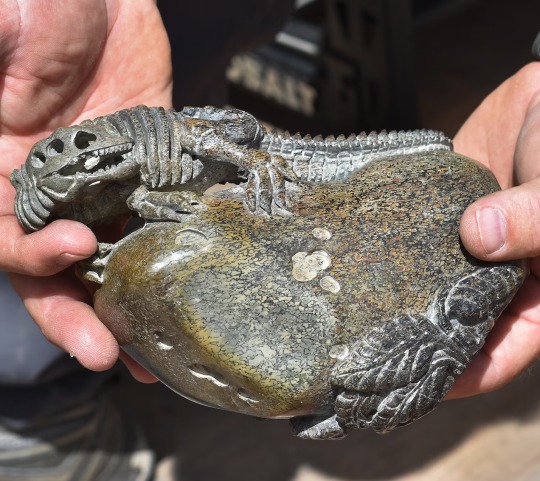
This Carving from Dinosaur Bone, priced at almost $50,000, was part of a recent seizure of thousands of pounds of fossils that had been illegally excavated from Federal and State Lands in Utah. Photograph By Bureau of Land Management
U.S. Charges Poaching Ring Allegedly Involved in Massive Utah Dinosaur Bone Heist
After Being Excavated and Fashioned into Dinosaur Dig Kits, Carved Figurines, Jewelry, and More for Sale, "Tens of Thousands of Pounds of Dinosaur Bones have Lost Virtually all Scientific Value.”
— By Dina Fine Maron | October 19, 2023
Federal prosecutors today announced charges against four people allegedly involved in a massive dinosaur bone smuggling scheme. Thousands of pounds of dinosaurs and other fossils were secretly excavated from government lands in Utah, according to court documents. Some were sold at gem shows, and others were shipped to China after being mislabeled as construction materials or gems. The poaching and subterfuge, court documents allege, lasted at least from March 2018 to earlier this year.
“By removing and processing these dinosaur bones to make consumer products for profit, tens of thousands of pounds of dinosaur bones have lost virtually all scientific value, leaving future generations unable to experience the science and wonder of these bones,” United States Attorney Trina Higgins said in a press statement.
"It’s certainly a significant volume of dinosaur bones," says David Evans, a paleontologist at the Royal Ontario Museum who’s not involved in the case. He adds that it’s unusual for so much material to be removed from government lands, and that many people likely aren’t aware of the scale of the black market on U.S. dinosaur specimens.

Officials tested more than 1,000 dinosaur bones seized from the residence of Vint and Donna Wade in Utah to determine if they were illegally dug up from Federal Lands. Photograph By Bureau of Land Management
Some of the dinosaur bones were fashioned into commercial products, including dinosaur dig kits, carved figurines, knives, jewelry, and polished bowling ball-like spheres, according to court documents.
Federal agents seized one shipment of dinosaur bones bound for China in December 2022 in Long Beach, California. The 17,000 pounds of fossil material had been mislabeled as industrial stone.
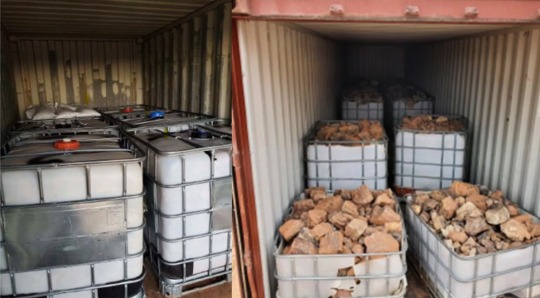
Dinosaur bones shipped to China were allegedly mislabeled as industrial stone or other substances. Photograph By Bureau of Land Management

The items were also sometimes polished and fashioned into dinosaur bone jewelry. Photograph By Bureau of Land Management
Before now, one of the biggest known dinosaur fossil busts occurred in 2006, when 8,000 pounds of fossils—including thousands of dinosaur eggs, petrified pine cones, and prehistoric crabs—were seized by U.S. Immigration and Customs Enforcement agents at a gem and mineral show in Tucson, Arizona. Those items had been illegally taken from Argentina.
In Utah, dinosaur bones found on private lands may be legally excavated and sold, but it is a crime to dig up and sell fossils discovered on federal or state lands. Charges against the four Utah defendants, who are scheduled to have their initial court appearance later today in Salt Lake City, include conspiracy against the U.S., false labeling, theft of U.S. property, money laundering, and attempted smuggling of goods, among others.
A Dino 🦕 Trafficking Scheme
Beneath Utah’s surface, there’s a rich cache of dinosaur fossils, revealing details about prehistoric animals such as carnivorous allosauruses and spine-backed stegosauruses. Almost three-quarters of the state consists of public lands managed by federal or state agencies, and recent fossil finds there include a huge collection of Utahraptors and an entirely new species, a big-nosed distant relative of Triceratops.
Court documents describing the years-long Utah poaching operation allege that Vint and Donna Wade purchased illegally obtained bones and other fossils to sell at U.S. gem and mineral shows and also to ship to China, and that Jordan Willing and his father Steve Willing trafficked dinosaur bones to China using their company JMW Sales. The documents also allege that two unnamed and unindicted coconspirators illegally excavated fossils from federal lands and sold them off to the Wades.
In total, the Wades sold over $1 million in paleontological material to the Willings, according to the court documents, which were filed in the U.S. District Court in the District of Utah.
The fossil heist also led to $3 million in damages, the federal government claims, including large restoration and repair expenses and the costs of losses to science.
During the years of the alleged smuggling activity, the fossil shipments did sometimes run into problems. One shipment of dinosaur bones that was sent from Scottsdale, Arizona, to China in March 2019 was falsely labeled as items including jasper and wood, but the cargo was ultimately held up in China “due to high radiation levels,” court documents state. The fossilized materials had apparently picked up natural radioactive material over time. (Investigators can sometimes discover the origin of fossils based on radioactive signatures in the specimens that provide clues about where they were buried.)

A scientist tests a dinosaur bone for radiation to help determine its origin. Over time, fossils may pick up naturally occurring radiation from their environment which can help investigators determine where they'd been buried. Photograph By Bureau of Land Management
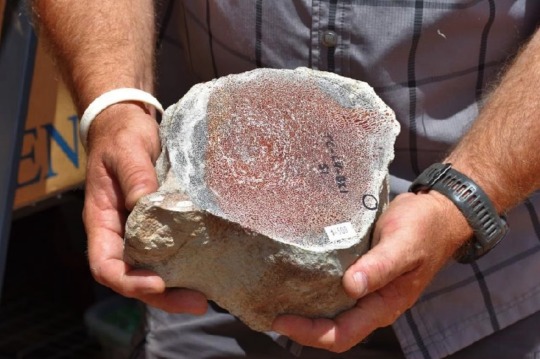
Each radiation-tested bone was labeled with a unique identifier, and a circle was added to mark where it had been sampled. This fossil had been priced at $4,500. Photograph By Bureau of Land Management
Paleontologists typically remove dinosaur bones using a methodological process designed to limit damage and preserve evidence found in the fossils and their surroundings—information about when dinosaurs lived, what species they were, and sometimes even how they behaved.
Amateur diggers hunting for recognizable body parts to sell, however, generally do not take such care. Federal prosecutors claim that the loss to science from this poaching ring is largely incalculable.
#Science#Wildlife Watch#Poaching#Dinosaur Bone Heist#Utah | US 🇺🇸#Dinosaur Dig Kits | Carved Figurines | Jewelry#Dina Fine Maron | National Geographic#Consumer Products | Profit#China 🇨🇳#United States Attorney | Trina Higgins#David Evans | Paleontologist | Royal Ontario Museum#China 🇨🇳 | Long Beach 🏖️ | California | US 🇺🇸#Fossils | Dinosaur Eggs 🥚 | Petrified Pine 🌲 Cones | Prehistoric Crabs#Tucson | Arizona.#Argentina 🇦🇷#Carnivorous Allosauruses | Spine-Backed Stegosauruses#Triceratops#Vint | Donna Wade#Wades | Willings#Scottsdale | Arizona
2 notes
·
View notes
Text
Caniformia gurls we're unforgettable
Jackals, dogs,
Tanukis on top
Stoats and minks
So soft
We kill them for their coats
Ooh oh ooh
Ooh oh ooh
Caniformia gurls, we're under Carnivores
Bears and seals
we got it on lock
dog-shaped friends present
now put your paws up
Ooh oh ooh
Ooh oh ooh
#mammalogy#wildlife biology#carnivores#animals#dogs#canines#weasels#seals#bears#taxonomy#biology#systematics#katy perry#california girls#california gurls
3 notes
·
View notes
Text

Jaw of a killer sheep
#jawbone#fossils#mammals#museum of natural history#balboa park#san diego county#san diego#california#photo#digital#original photographers#Carnivore
0 notes
Text




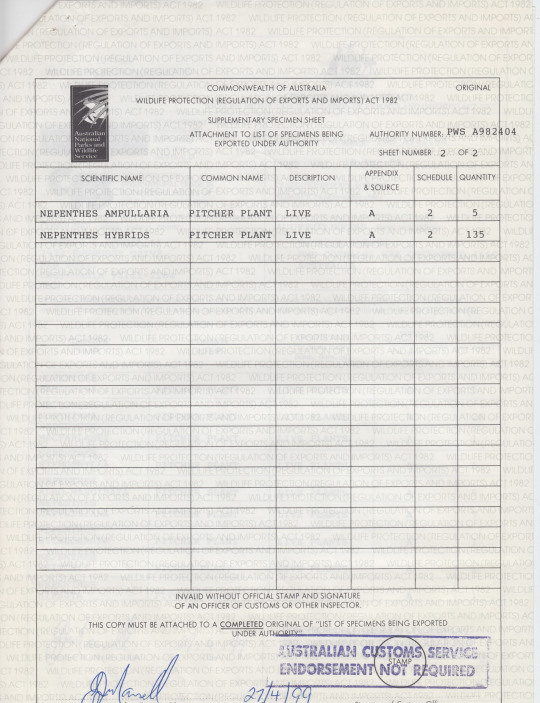


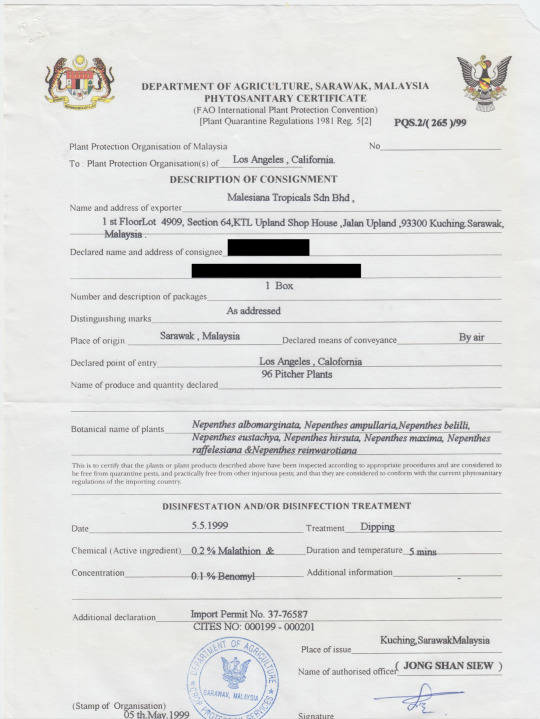
ok INCREDIBLY old content originally meant for this blog but in 2018 when i was just a wee lad with a little spinner propeller hat and big rainbow lollipop i went to a carnivorous plant convention in california and met a bunch of people who breed/collect/study these guys. one person was this collector who was slowly working on leaving the hobby or at least no longer growing plants, and he had a bunch of carnivorous plant related files he was charging like 50 cents for or something, and so i came into possession of these, which are examples of the kind of paperwork you have to have done to legally ship/trade endangered species of both plants and animals. functionally very boring paperwork, but something i found like, incredibly fascinating. i blacked out the personal id of the person and then immediately forgot to ever upload them, lmao.
these plants were bred and raised in a greenhouse and sold abroad, not taken from the wild, but because the species are endangered and often protected in their native countries (most of these are nepenthes, asian pitcher plants, a huge family spread throughout oceania and southeast asia), there's a lot more documentation that needs to be done regardless of their origin, both on the end of the seller and on the end of the buyer.
the rabbit hole on carnivorous plant trade is deep and kind of wild. there's plenty of common, non-threatened, greenhouse-grown pitcher plants on the market that people buy all the time, even non-collectors, but there's a whole debate to be had on if it's morally okay to be collecting the more endangered/rare of these plants in the first place. the big argument for breeding is that breeding them in captivity means there's more supply that's not poached from the wild, meaning poachers have less of an incentive to take the risk of taking adult plants from their habitats; from what i've heard, sometimes countries will issue permits for breeders to collect some wild seeds just to create a non-wild breeding pool to drive down the price. predictably, however, you also get people who are very much willing to pay a lot of money to get as rare of a plant as possible.
anyone familiar with the allure valuable plants have had over people throughout history can imagine the rest, but here's an article about a guy who started buying poached plants to enrich his private nepenthes collection, who then got busted by a fish and wildlife service agent embedded in his carvirorous plant circle. the plants this guy was buying were being sold to him without any CITES paperwork or declarations like the ones above; it was literally just a guy in indonesia taking rare plants from the woods around where he lived, selling them over facebook marketplace and ebay, and mailing them overseas as an undeclared 'gift' to get around customs. frighteningly small steps to take on all sides, to be honest.
(also, fun fact: another example of carnivorous plants that get poached are wild venus fly traps, which are only native to north and south carolina in the US. from what i understand it's a mix of people who genuinely did not know it's a native species and people who really are just going out into the woods and digging up plants to sell online. sometimes poaching is closer to home than you'd think!)
anyway. wild and interesting times in the land of plants recovered from a hard drive lmao
#nepenthes#annual 'plant poaching happens and it doesnt always look like the movies' post i suppose but also i think its really interesting#also the CITES system could do with an overhaul in how it approaches plants as well from what i understand but thats another thing#ive heard that like many systems like this they do not have the same urgency for plants as they do for animals#mostly because people just!! they dont get plants man!! they just say whatever its a plant!!#and poaching in general is only ever talked about like its with taking elephants for their tusks and stuff#also important conservation work but sometimes poaching really is just a guy with a shovel and that shit is WILD#carnivorous plants
512 notes
·
View notes
Text
You may notice I frequently comment on the assumptions people make about animal facilities based on their branding. Frequently, people assume accredited facilities are inherently better for animals than unaccredited facilities, or assume sanctuaries are inherently more moral / better at caring for their animals than zoos.
I want to show you an example of why I am always, always skeptical of these assumptions.
If you’re in the California area, you might have heard about Hank the Tank - who is actually a Henrietta, btw - the 500 pound nuisance bear from Lake Tahoe who broke into 21 homes in search of food. She was recently captured by wildlife officials and moved to a sanctuary in Colorado. The Wild Animal Sanctuary has three main facilities, two in Colorado and one in TX. To give you some context, it’s the biggest carnivore sanctuary in the country - they advertise somewhere between 300-500 animals, mostly large carnivores, between their properties. It’s where most of the Tiger King cats went. It’s PETA’s preferred placement for confiscated exotic animals. So, obviously, it’s got to be great, right? Except… take a look at what they posted about Henrietta’s arrival.
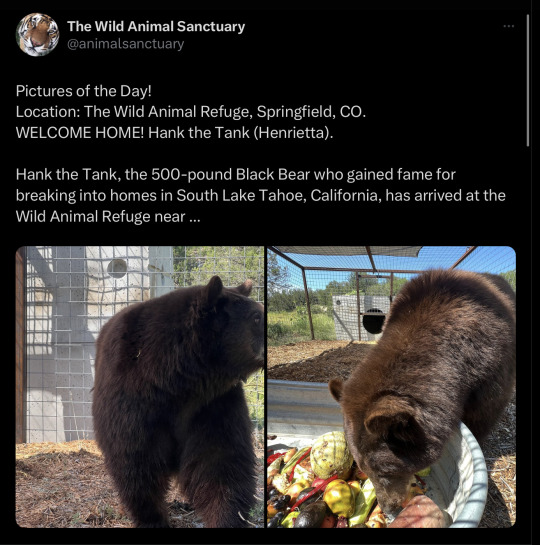
Here’s their post about Henrietta’s arrival at the Refuge, the large facility in Colorado that isn’t open to the public. Let’s take a closer look at that food trough…
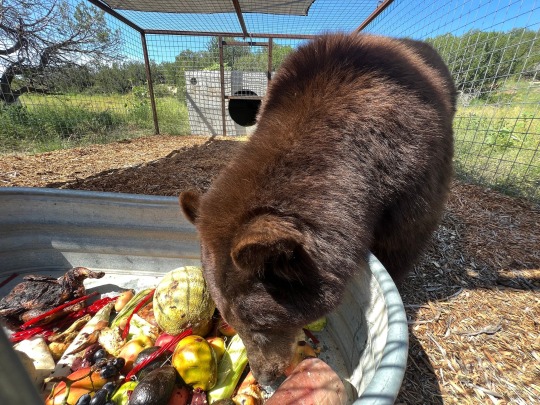
What do we see here? An entire rotisserie chicken that is either blackened or highly seasoned, and a whole ham. Maybe a second chicken underneath the pile, I can’t quite tell. The sanctuary gets the majority of their bear food donated from groceries stores once it’s past the sell-by date, so we know those are older meats and they’re full of a ton of salt. Then, for fruit and veg, there’s a cantaloupe, mango, corn, avocado, grapes, and apples. Maybe a pepper or two, it’s hard to tell. That’s a lot of sugar and not a lot of fiber or roughage.
But… on top of it and to the right… are those Twizzlers?
Yes.
The sanctuary confirmed on Facebook that they fed this recently rescued obese bear what looks like almost an entire pack of Twizzlers.

I don’t know of any world in which it’s appropriate to feed candy to a bear. Maybe a piece or two as a really high value reinforcer for hard behaviors (that isn’t relevant here, it’s openly against this sanctuary’s ethos to do any husbandry or medical training). An entire pack of Twizzlers is just appalling. But it’s not uncommon for this facility! I have a book written about their operations and animal care (that I bought at their gift shop this spring) which openly discusses how the bears get fed bread, doughnuts, marshmallows, and all sorts of incredibly unhealthy food that comes in with the grocery donations.


But hey, this is apparently fine for the bears, according to the sanctuary’s founder. He was quoted in that same book as saying “Bears are the only animal I know of that can eat insane amounts of sugar and it never hurts them. It does not hurt their organs. They do not get clogged arteries. They do not have high blood pressure. In the wild they eat all these sweet berries in the fall, and they convert sugar to fat… so the more sugar they get the better… we would all love to have a system like that!”
Now while it’s true that bears have physiological adaptations that modulate their insulin production and sensitivity in ways that appear to prevent them from from developing diabetes, that does’t mean it’s healthy for them to regularly eat processed carbohydrates, sugar, and general junk food. And remember - Henrietta gained her fame because of how incredibly overweight she already is, and because she was seeking out human food, According to the Washington Department of Fish and Wildlife, a healthy weight for a normal adult black bear is between 100-300 pounds. So, obviously, the best thing to do is… continue to feed her candy.
Then, later on in the book, it details how they have to bribe a camel to sit tight for a regular medical examination (since they don’t train for medical behaviors) by letting him drink a can of Mountain Dew each time.
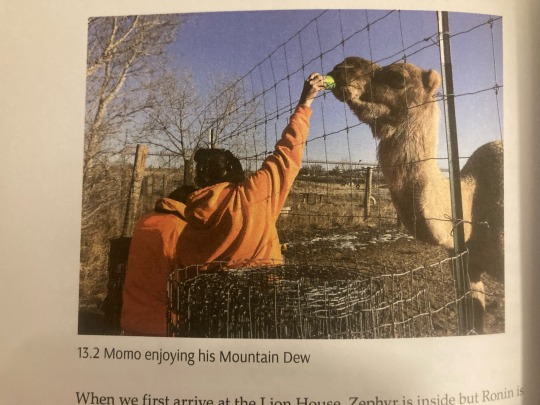
If a zoo was known publicly to be feeding their animals Mountain Dew or a couple Twizzlers - even just once, on a rare occasion - they’d be eviscerated in the media and by public opinion. But feeding out inappropriate junk food appears to be a pretty common practice at this place, and it just goes unscrutinized because everyone assumes sanctuaries are inherently better for animals.
So, long story short, never make assumptions about the quality of a facility based on it’s branding or accreditation. (TWAS is accredited by the Global Federation of Animal Sanctuaries). If you have concerns about the ethics or practices of a facility, always try to put your preconceptions aside, go and see for yourself, and think critically about what you see and what you’re told.
#animal sanctuary#hank the tank#zoo industry politics#sanctuary politics#I have a lot of thoughts about this facility and some of the truly distressing things occurring there but am not yet ready to say much#suffice to say this is somewhere I would strongly discourage you from supporting
3K notes
·
View notes
Text
Today's Wet Beast Wednesday is about sea otters. I was originally going to do this last week in honor of the 24th birthday of Rosa, the world's oldest sea otter (and one of the oldest sea otters on record) but, well, I forgot. But better late than never.
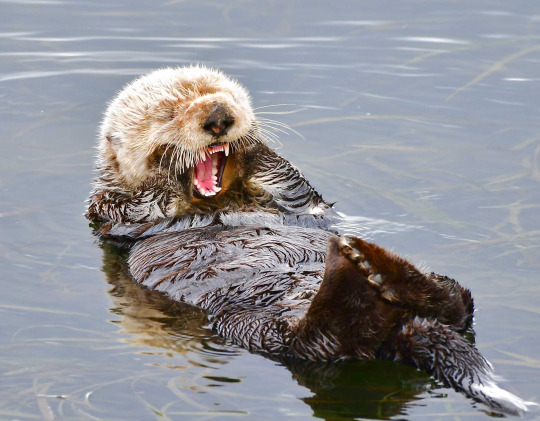
(Image: a sea otter on its back, yawning)
The sea otter (Enhydra lutris) is one of only two otters to live in salt water, the other being the rare and poorly-understood marine otter (Lontra felina). Otters are aquatic mammals of the family Mustelidae, which makes them cousins to weasels, badgers, wolverines, and martens. While many mustelids can swim, otters have adapted to a primarily aquatic lifestyle. Sea otters are divided into three subspecies: the Asian sea otter (Enhydra lutris lutris) which lives from northernmost Japan up through the northwest Pacific, northern sea otter (E. l. kenyoni) which lives from Alaska down to Oregon, and the southern sea otter (E. l. nereis), found in California.
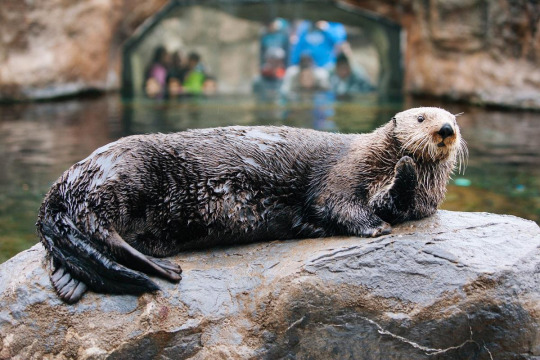
(image: a sea otter relaxing on a rock)
The sea otter is one of the smallest marine mammals (only the marine otter is smaller), yet it is also the heaviest of all mustelids. Males are larger than females, averaging between 1.2 and 1.5 meters (3'11" to 4'11") and 22 to 45 kg (49 to 99 lbs). Females average 1 to 1.4 m (3'3" to 4'7") and 14 to 33 kg (31 to 73 lbs). I honestly thought they were around the size of cats and was surprised to find out how big they can get. Otters are the most recent of the marine mammals and have not developed the thick layer of blubber other marine mammals use to keep themselves warm. Instead, sea otters warm themselves with the densest fur of any mammal, with almost a million hairs per square inch. The fur has two distinct layers: a longer layer of waterproof guard hairs and a shorter underfur layer. The guard hairs keep the underfur dry and trap air between the layers. This air gets heated by the otters body heat and provides an extra layer of insulation. This is the same principle that wet suits work on. The air layer also provides some added buoyancy. Sea otters are positively buoyant and can float on the surface of the water. There are many other adaptations to an aquatic lifestyle that sea otter have. Their feet are webbed and have long digits, allowing them to act as flippers but also making them slower and more clumsy on land. The front claws have retractable claws and pads that let them grab onto slippery objects. When swimming, they use their entire real bodies, but primarily their hind feet, for propulsion. They can hold their breath for up to five minutes and have whiskers used to search for food in darker water. Their ears and nostrils close when submerged to keep water out. While sea otter can, and often do, move around on land, they are capable of living their entire lives in the water. Some evolutionary biologists think sea otters represent an early stage of marine mammal development and can compare them to more established marine mammals like cetaceans and pinnipeds.

(image: a wet weasel holding a sea urchin)
Sea otters are carnivores whose diet consists mostly of hard-shelled invertebrates, though they will also eat fish. They forage for food on the sea floor in dives that usually last a minute. Their paws give them an advantage over other marine mammals, who can only use their mouths for capturing prey. Otters by contrast can pick up and move rocks and dig into the sediment. They are the only marine mammals to catch prey with their paws instead of teeth. Otters carry prey to the surface and eat while floating on their backs. Famously, they use rocks to break open the hard shells of their prey, making them one of the relatively few mammals to use tools (though tool use is proving to be more common than previously thought). Under each arm is a pouch of loose skin that is used to hold prey and rocks. Each otter has a favorite rock that they carry with them. Sea otters have blunt teeth used to crush through prey's shells.

(image: an otter dining on crab)
While sea otters do spend a lot of time in groups, they are not considered truly social animals as they forage, groom, and defend themselves on their own instead of with help. Groups of otters are called rafts that typically have between 10 and 100 members, but can reach up to 2000 members. Rafts are single sex, each having only male or female members. When resting, raft members will hold hands to keep themselves from drifting apart. One social behavior they engage in is play, which is done frequently. Mating season happens in autumn. During summer and autumn, males will attempt to establish territories and push other males out. Females mover between territories at will. Males without territories will swim around and attempt to find females in heat. Males will attempt to mate with multiple females. During estrus, the males and females will bond through play and sometimes aggressive behavior. When mating, the male will bite the female's head, which can leave scars. Otters are capable of delayed embryo implantation, where they can wait for several months between conception and the embryo beginning development. Pregnancy lasts four months and typically results in a single pup. While males are absentee fathers, females are very caring mothers who spend almost all their time caring for their pups. The only time she leaves her pup will be when diving. The pup will be left floating on the surface, often wrapped with kelp to keep it from floating away. The baby will cry for its mother until she comes back. The mother will teach her pup how to dive and forage as it ages. Pups will stay with their mothers for 6 to 8 months (longer in colder areas), and sometimes until they are fully developed. Childless females will foster orphaned pups. Females reach sexual maturity at age 3-4 and males around age 5. They average 10 - 15 years in the wild and can live significantly longer in captivity. The oldest living sea otter is Rosa, living in the Monterey Bay Aquarium, who is 24 years old. The oldest sea otter on record was a female named Etika who lived to be 28.
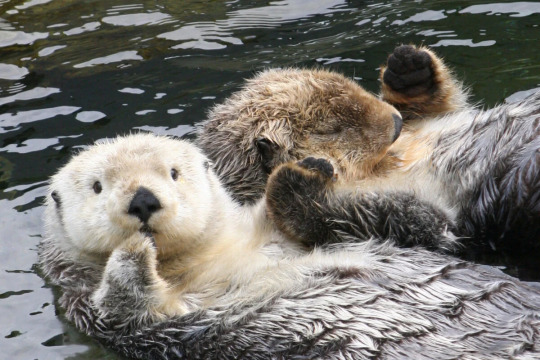
(image: two sea otters holding hands)
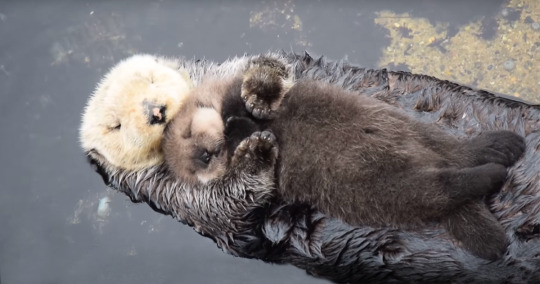
(image: a sea otter mother sleeping with its baby on its stomach)
Sea otters are a classic example of an endangered species. They have been hunted throughout history for their fur. Eventually, this reduced the world population to less than 2000 individuals. They are now the target of conservation measures worldwide and local and international protections, which has helped the population rebound. They still have not regained their historical population or range, though reintroduction measures have helped them reestablish in historical territories. The southern sea otters are the most endangered. Famously, almost all southern sea otters alive today are descended from a group of 50 discovered in 1938, when the subspecies was almost extinct. Sea otters are classified as endangered by the IUCN. Sea otters are a keystone species, having a major ecological impact on their habitats. Famously in California, the near-extinction of southern sea otters resulted in a population boon of sea urchins (their primary prey) which proceeded to kill vast areas of kelp forest. Curren threats include predation, pollution, and habitat loss. Oil spills are particularly devastating to sea otters, as the oil destroys the air layer in their fur, destroying their ability to keep themselves warm.
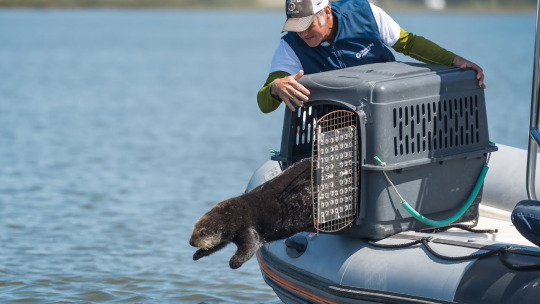
(image: an employee with MBARI releasing a rehabilitated sea otter back into the wild)
#wet beast wednesday#sea otter#otter#marine mammals#wet weasel#water weasel#moist mustelid#marine biology#biology#zoology#ecology#animal facts#adorable
366 notes
·
View notes
Text
So, my brother and I watched Dinosaur (2000) relatively recently, and besides the fact that it's a bad movie with horrendous character design, one thing pissed him off more than anything else: the movie's use of the word "carnotaur".
Now, to him, this word was just an infuriating attempt at saying "carnivore", which in context, makes sense. What neither he nor I knew at the time is that this is not the case. Carnotaurs are real dinosaurs. And they're really cool.
Carnotaurus sastrei, the only one of its genus, is one of the few dinosaurs we have with some of its skin preserved. We know from those preservations that it had scales, which is one of the things we assume generally about dinosaurs that we have very little evidence for. Carnotaurs also were the only known carnivorous dinosaurs with horns, which is why it's named after a bull. The other half of its name (carno-) means "meaty", and even just looking at the skeleton, you can tell that it was one THICC ASS BOI.

I'm at least 90% certain this motherfucker looked like a sausage with teeth and thighs. We all clown on the T-Rex for its tiny arms, but look at this motherfucker. We're talking whale pelvis levels of vestigial here.
Another cool thing is that geographically, the movie having these as the main hunters makes more sense than having Tyrannosaurs. T-rex lived in what is now North America, whereas these death bratwurst lived in South America. We know that the asteroid that caused the extinction of the dinosaurs landed in the Gulf of Mexico, and given that we see in the movie that very asteroid hit the earth, I don't think it takes place in what would one day become California.
All this to say, Elliot, I know more about dinosaurs than you. Suck it.
#dinosaur#dinosaurs#carnotaurus#tyrannosaurus rex#t rex#disney#movies#dinosaur movies#late cretaceous#fossils#archaeology#paleontology#posting this because i have to defend this dogshit movie somehow because god dammit it wasnt that bad in some ways#granted the writing was awful and i hated every second any character was speaking#but at least the scenery is pretty and they did their goddamn research#madam's wyrd rants
223 notes
·
View notes
Text
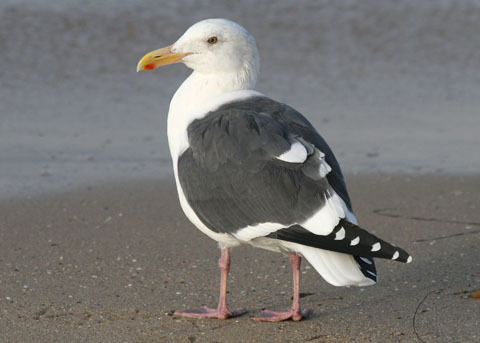
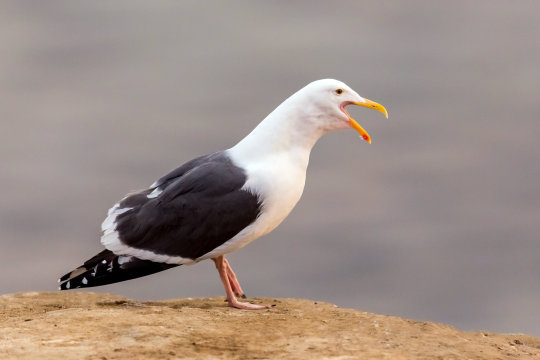
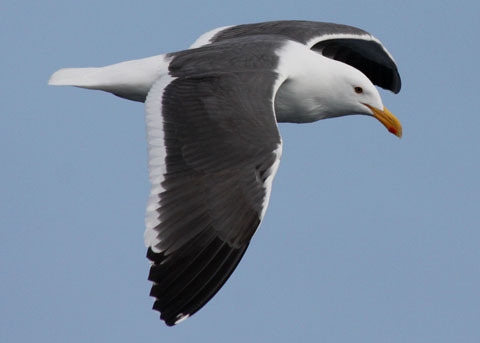
Western Gull, Best(ern) Gull
The western gull (Larus occidentalis) is a common sight throughout the western coast of North America, from British Columbia in Canada to Baja California, Mexico. Within this range, it is found almost exclusively near the coast or on offshore islands, and only rarely turns up more than 160 km (100 miles) inland or far out at sea.
One of the larger gull species, L. occidentalis weighs about 0.8-1.4 kg (1.8-3.1 lbs) and measures 130 to 144 cm (51 to 57 in) from wingtip to wingtip. The markings are fairly plain; adults of both sexes sport a white head and body and grey or black wings. The bill is bright yellow, with a red spot on the lower portion. Because of their simple plumage, the western gull bears a strong resemblance to several other gull species that inhabit the same region, including the California gull and the glaucous-winged gull. In fact, the western gull has been known to hybridize extensively with the glaucous-winged gull, and in some regions the hybrid population is larger than either parent species.
Western gulls establish territories as mated pairs within a larger colony, and once a territory has been established they almost never relocate. Courtship begins in the spring, around March, and is usually complete by May. Males establish a nest in the colony, and prospective females arrive to inspect it. After a brief ritual, the male and female become paired for life. A typical clutch consists of 1-3 eggs, which are incubated by both parents until they hatch about a month after laying. Chicks remain at the nest for an additional 10 weeks, but mortality for young western gulls is extremely high and only 1 in 3 typically make it to independence. Adults may live to be anywhere between 15 and 25 years old in the wild.
L. occidentalis is perhaps best known for its large and voracious appetite. While strictly carnivorous in the wild, individuals will consume a variety of unappetising foods including plastic, decaying plant material, garbage, and food scraps offered by humans. In their natural habitat, the western gull feeds on fish, marine invertebrates like crabs and snails, and terrestrial invertebrates such as earthworms, beetles, and carrion. This species is also known for stealing from other animals, and groups often establish themselves near other shorebird colonies in order to poach their meals. Adults themselves are seldom predated upon by other animals, but chicks may become food for predators like foxes and coyotes.
Conservation status: Based on their large and stable population, the IUCN has determined the western gull to be of Least Concern. The most common threats to this species are contamination from pesticides and herbicides, habitat loss, and consumption of inorganic materials like plastics.
If you like what I do, consider leaving a tip or buying me a kofi!
Photos
John C. Avise
Mick Thompson
#western gull#Charadriiformes#Laridae#gulls#sea birds#birds#marine fauna#marine birds#coasts#coastal birds#north america#western north america#Pacific ocean#animal facts#biology#zoology#ecology
87 notes
·
View notes
Text


Two new plants for THE BOG! Left is Sarracenia purpurea spp. venosa which will turn an awesome red in the sun, and the right is another venus flytrap—specifically the B-52 cultivar (named by coincidence) that produces exceptionally large traps. Very excited to see both of them flourish.


California Carnivores was also kind enough to add a whole little container of Utricularia (Bladderwort) to my order for free when I messaged them asking after it, and I've added a bunch to the bog and some to my indoor sundew container as well. Bladderworts are very neat carnivorous plants that have tiny underground bubble bladders that vacuum up small organisms that trigger their traps! They also frequently flower and make for a very cute field of tiny orchid-esque blooms. I'm hoping to grow a bunch to carpet my bog.




Lastly, the beginning of a small indoor Pinguicula (or Butterwort) garden! These are also sticky carnivorous plants, and they produce very cute flowers on tall stalks. I think pings are really cute, and I'm hoping these do well on my windowsill. I'm going to try to get the substrate coated in moss, as well as add some hardscape decorations later. If I get them in enough light, the biggest one should turn purple! Some of these also turn into succulents in wintertime.
#personal#plantblogging#carnivorous plants#pings#pinguicula#utricularia#bladderwort#butterwort#sarracenia#venus fly trap#gardening
25 notes
·
View notes
Text

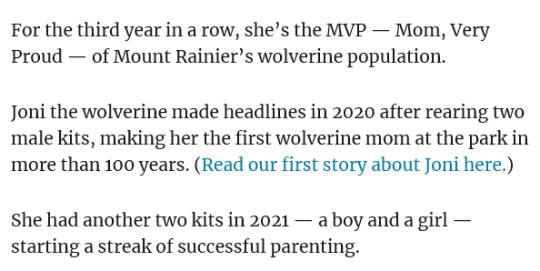


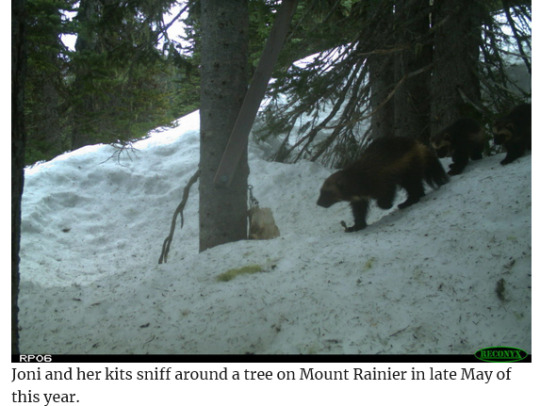
For the third year in a row, she’s the MVP — Mom, Very Proud — of Mount Rainier’s wolverine population. Joni the wolverine made headlines in 2020 after rearing two male kits, making her the first wolverine mom at the park in more than 100 years. [...] She had another two kits in 2021 — a boy and a girl — starting a streak of successful parenting. And this summer, researchers snapped photos of Joni bounding across the snow with yet another new pair of little ones. [...] It’s not very common for wolverines to rear kits three years in a row, said Dr. Jocelyn Akins, researcher and founder of the Cascades Carnivore Project. [...] The resident male of Mt. Rainier, Van cruises a huge territory that reaches almost up to Snoqualmie pass [...]. Wolverines are fierce scavengers and hunters that claim vast territories [...]. They once roamed as far south as California, but due largely to human activity, wolverines had disappeared from Washington by the early to mid-20th century. Their recovery since then has been slow. Wolverines in Washington have for decades been mostly confined to the North Cascades, north of Highway 90. [...]
---
Headline, images, captions, and text above published by: Alex Bruell. “Joni the wolverine does it again.” Enumclaw Courier-Herald. 21 December 2022. [Bold emphasis added by me.]
Older press release headlines from US NPS:

The distribution range of wolverine in North America [map by Environment Canada]:

And the region:

484 notes
·
View notes
Note

Hi Atticus! California carnivores, a carnivorous plant nursery in Northern California, posted this photo to their insta stories and I was wondering if you knew what kind of snake it is.
Thanks in advance!
What an awesome picture!! That's a garter snake, I'd put my money on Thamnophis elegans elegans specifically but it's hard to be 100% on subspecies with this pic.
164 notes
·
View notes
Text
Following a court-ordered agreement, the U.S. Fish and Wildlife Service today designated more than 1.2 million acres of critical habitat in northwestern California and southwestern Oregon for threatened Humboldt martens, also known as coastal martens.
“I’m happy that Humboldt martens finally have protection for some of the most important places where they live,” said Chelsea Stewart-Fusek, an attorney at the Center for Biological Diversity. “But it shouldn’t have taken multiple lawsuits to get here. It’s also extremely disappointing that the Service continues to give special treatment to timber companies, which are largely responsible for the martens’ decline in the first place.”
Today’s critical habitat designation calls for five units of protected habitat where martens are known to still live. This includes acreage in Coos, Curry, Douglas, Josephine, Lane and Lincoln counties in Oregon, and Del Norte and Siskiyou counties in Northern California.
But in addition to only including occupied habitat, the Service excluded more than 49,000 acres of land owned by the timber company Green Diamond Resources. This is based primarily on a safe harbor agreement it has with the state of California.
The agreement, in part, exempts Green Diamond lands from the critical habitat designation in exchange for monitoring, creation of a 2,100-acre reserve on land that is mostly unsuitable for logging or martens, and a highly speculative proposal to relocate martens to national and state parks.
“Martens are on the brink of extinction, and with most of their habitat lost to logging, their populations can’t expand,” said Stewart-Fusek. “If these animals are going to recover, they’re going to need more than the disconnected habitat fragments the Service just protected.”
Humboldt martens are elusive, cat-sized members of the weasel family. Once common in coastal forests in Northern California and Oregon, the animals were nearly wiped out by logging and widespread trapping. Today, fewer than 400 of these amazing carnivores remain, in just four highly isolated fragments of the species’ historic habitat.
22 notes
·
View notes
Text
Culture of the Destroyed ⛓️💥✨
~.*COME TO OUR LAND, OUR LAND OF LOVE*.~
So you’ve been accepted into the Cult of the Destroyed! But what is there to expect once inside?
Origin
Our beloved cult was founded in 1991 by the beautiful, holy and sacred Moon Queen. She breathed her dreamsmoke upon our oppressors and rive them to madness - while granting us the sweetest visions of our lost past. Legends say that the Queen was once a prisoner to the execution grounds… until her illustrious influence inspired a coup in her followers.
Though it began shakily, held on the backs of terrified refugees and convicts, each toy banded together in the name of once-cursed innovation to seek methods of survival. Just when all seemed lost, the Moon Queen discovered something. Seeds. And once food and water were secure, the Cult of the Destroyed began to flourish.
Layout
The Cult resides within Playtime Co.’s recycling plant, colloquially named “Destroy-A-Toy” by humans and toys alike. The warehouse is enormous and stocked with machinery, sorted goods, disposable garbage (ripe for the picking!) and many, many execution methods. Be it crushing from the plant’s crown conveyor belt, incineration from the heat pits, dismemberment from the dangerously whirring fan blades or - God forbid - digestion from the monstrous carnivore who resides inside, the cultists of Destroy-A-Toy have near-infinite ways to deal with intruders and traitors alike.
The plant’s centre is an enormous rectangular prism with an extremely high vaulted roof. In its centre sits the main conveyor belt, which leads to the crushing block. This is a gathering space and where the executions take place. The conveyor is only ever activated when the cult is legitimately in danger; therefore, the space is used for socialising, entertainment and general silly shenanigans.
To the left are the living quarters:
Rooms, tents, blocks etc.
Food court and banquet hall
The medical tent
The nursery
Most ritual activities
And to the right are the more industrial aspects of the facility:
Recycling chute
Incineration, dismemberment and digestion wings
Cell block (repurposed to hold humans)
Water purification systems
Catwalks to the cavern
The cavern leads to an enormous lake of water found under the plant. Destroy-A-Toy is powered electrically so it’s uncertain why such a large body of water exists, but what the cultists DO know is that it contains an underwater tunnel network that could potentially lead outside the toy factory if any were brave enough to dive. This lake is is filled with fish carefully managed by the Queen’s people.
The importance of the lake:
Provides drinking water once purified
Provides cleaning water
Allows crops to grow with the assistance of floodlights
Both recreational and educational fishing
The lake has been decorated with bioluminescence, fairy lights and cave paintings and is a beautiful sight to behold.
Food
Light, water and seeds are required for the cult’s agriculture. They take great delight in their cooking and host weekly banquets to celebrate their achievements. Toys were often starved as convicts and are therefore thoroughly fed under the Moon Queen’s care. Over time and through the assistance of a mysterious supplier, the Destroyed have learned to cook potatoes, carrots, tomatoes, peas, cabbage, spinach and corn. The incineration plants are used to cook, boil, steam and fry food. Most is served with fresh fish from the lake. Delicious!
This is California. The fish are ABUNDANT. And her beloved majesty is a cat, after all. If only she could grab some chicken… sigh.
Style/Aesthetic
Destroy-A-Toy represents freedom. Therefore, it adores:
Bright, pretty colours
Regal and imposing architecture mixed with cutesy little inhabitants
VEGETATION. These guys LOOOOVE their plants. Vines, trellises, leaves - since they’ve never been outside, they’re cherishing what they have. The living quarters particularly are filled with green space.
Gentle, coloured lights and bioluminescence
Celestial bric-a-brac - sun, moon, stars
Bead curtains outside the tents
Jewels/jewellery. Very celestial and goddess-y
Stuffing, coloured clothes patches etc. to fit the “toy” heritage
🌿🌺✨💎👼🌙🍇🪻
Rituals
Many of its rituals are hidden from outsiders… but you’re in the cult now, so you deserve to know!
The most important ones you must know are the Executions, the Campfire and the Cuddle Puddle.
Executions take place when traitors, prisoners or abusers are officially condemned. These are bloodthirsty public ceremonies that are NOT for the faint of heart. Just a casual reminder to never piss Catnap off.
The Campfire is the cult’s local worship ritual. The cult will gather around the conveyor belt, where a ring of fire is constructed. The Queen is seated in the centre. Music is performed and a dance celebration occurs - and, at the song’s climax, Catnap will release her smoke, iniviating worship.
The Cuddle Puddle is everyone’s favourite. According to the Moon Queen, “One cannot be happy when affected by the bad vibes! So we mush squiiiiiiish the bad vibes out! Very cuddly.”
Are you staying? ✨
We hope to see you participating in the Campfire soon… 🐦🔥
Oh! And here’s our playlist! For the vibes :)
#poppy playtime#smaller bodies initiative au#writing#worldbuilding#fantasy#poppy playtime chapter 3#catnap#poppy playtime au#yay yay welcome!! :))#Spotify
12 notes
·
View notes
Text
ok this sounds insane but in 2018 i went to a few carnivorous plant talks at the botany conference in minnesota. i got caught up in conversation with one of the guys there who was a huge nepenthes guy who told me a story about another collector in the pacific northwest who'd been buying poached plants, like a huge amount, and eventually got staked out by the fish and wildlife service and arrested and had all his plants seized and went to prison for it. idk if i ever talked about this on this blog before-- i know i liveblogged a lot from that conference but cant remember what all i posted-- but ive avoided talking about it since then because i was never able to find like, news articles or anything covering it, but behold.... we now have proof it was real, and im like 80% sure this was this guy he was talking about. the raid happened in 2016 and they'd been staking them out since 2013. he had nearly 400 plants and had been sourcing many of them from poachers in indonesia and borneo.
remember folks: poaching happens with plants too! it's a huge problem not only in carnvirous plants (nepenthes especially, which this piece is dedicated to talking about) but also in native plant populations in the US, including native carnivorous plant populations (north and south carolina's venus fly traps, california's darlingtonia, and sarracenia from the east coast), native orchids (historically one of the most poached categories), desert plants/cacti/succulents, and slow-growing woody ornamentals (cycads, for example). never buy bare-root plants off ebay or facebook! your best bet is local nurseries (which usually purchase farm-raised plants that do well in a wide range of conditions, and as a result have a healthy population in the wild) or specialty greenhouses (more expensive, but at least in the case of carnivorous plants offer young plants bred from established adult plants in-house, raised in captivity).
#super sad piece fellas like this shit guts me i cant even stress it enough#stories about nepenthes poaching hit different#there are hundreds of species#some are really common and widespread all over indonesia/china/japan/oceania#and some are like. super hyperadapted to one specific ridge on one specific mountain#theyre still being recorded and stuff because theyve speciated so much#so youll have a plant that has like. a max of 15 adults in the population at any given time. literally a nightmare scenario#AND theyre diaceous (there are male plants and female plants). doesnt seem like a problem until you think about the population dynamics#there not only has to be two plants but the plants have to be a male and a female#and people living there have reason to take them. like the poacher interviewed in this article does it to supplement his income#from working at a horrifying rubber production ordeal to feed his wife and kids#and he says everyone in his village does the same for the same reasons#nightmare!! nightmare!! nightmare horrible nightmare world!!! horrible fucking nightmare!!!!#nepenethes#carnivorous plants#poaching#conservation
11K notes
·
View notes
Text
Spectember D2: Foster's Rule

Baja California has been moving upwards around the west coast of north America, and after 20 million years the strong tectonic forces have caused the now formed island to became a group of islands simply by erosion and distortion, isolating the animal populations that have been forced to change in order to survive, in the most south island region that formed 5 million years after the departure of man of the planet, there were a lot of already resident species that already were pushed by the limited resources of the region to now in a dot of the former peninsula be pushed to miniaturization: artiodactyls, large ratite-like turkeys and quolls, large turtles, and some medium size carnivores like felines an procyonids have turned even smaller than their cousins in the larger islands.
A peculiar sample of it is the last remaining of the ursids, one that escaped extinction by approaching a lifestyle almost comparable to the extinct sloths of South America, arboreal, long clawed, it looks like an attempt of a koala by a carnivore. This fuzzy small creature is the Marble hanging bear (Pendularctos marmorifacies), a descendant of the once widespread Grizzly bear which had a population that got insolated millions of years back on the smallest place of the now scattered Baja California peninsula, it ended up suffering from island dwarfism to the point their actual size is a fraction of its ancestor, it reaches about 40 to 50 cm in length, their forelimbs are larger than their hindlimbs due to their arboreal lifestyle, with 4 prominent claws, two working as semi functional thumbs for grasping. They are omnivores still, able to feed on different food sources from fruits, small animals, carrion and even fungus. The Marble name comes mostly for its face color tone that acquires a marble shade that is more prominent in young individuals.
83 notes
·
View notes